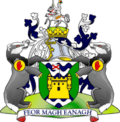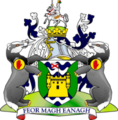County Fermanagh facts for kids
Quick facts for kids
County Fermanagh
|
||
|---|---|---|
|
||
| Nickname(s):
The Lakeland County
|
||
| Motto(s): | ||
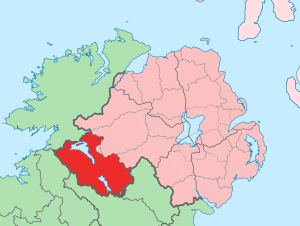 |
||
| Sovereign state | United Kingdom | |
| Country | Northern Ireland | |
| Province | Ulster | |
| Established | 1584/85 | |
| County town | Enniskillen | |
| Area | ||
| • Total | 715 sq mi (1,851 km2) | |
| • Land | 653 sq mi (1,691 km2) | |
| Area rank | 25th | |
| Highest elevation
(Cuilcagh)
|
2,182 ft (665 m) | |
| Population
(2021)
|
63,585 | |
| • Rank | 29th | |
| Time zone | UTC±0 (GMT) | |
| • Summer (DST) | UTC+1 (BST) | |
| Postcode area | ||
| Area code(s) | 028 | |
| Contae Fhear Manach is the Irish name; Countie Fermanagh, Coontie Fermanagh and Coontie Fermanay are Ulster Scots spellings (the latter used only by Dungannon & South Tyrone Borough Council). | ||
County Fermanagh is one of the 32 counties of Ireland. It's also one of the nine counties in Ulster and one of the six counties that make up Northern Ireland. People often call it "The Lakeland County" because it has so many beautiful lakes and waterways.
The county covers an area of about 1,691 square kilometers (653 sq mi). In 2021, around 63,585 people lived here. The main town, and the largest, is Enniskillen. Fermanagh is known for its stunning natural beauty, especially its famous lakes.
Contents
Geography and Nature
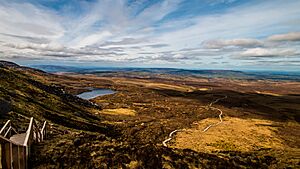
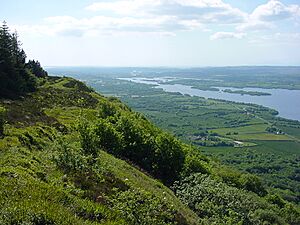
County Fermanagh covers a large area, and nearly a third of it is covered by lakes and rivers. The most famous are Upper and Lower Lough Erne and the River Erne. Forests also cover a big part of the land. Fermanagh is the only county in Northern Ireland that doesn't touch Lough Neagh.
Mountains and Lakes
The county has three main hilly areas:
- The West Fermanagh Scarplands are to the southwest of Lough Erne.
- The Sliabh Beagh hills are in the east, near the border with Monaghan.
- The Cuilcagh mountain range is along Fermanagh's southern border. Cuilcagh is the highest point in the county, reaching 665 meters (2,182 ft) high.
Fermanagh shares its borders with several other counties:
- County Tyrone to the north-east.
- County Monaghan to the south-east.
- County Cavan to the south-west.
- County Leitrim to the west.
- County Donegal to the north-west.
Fermanagh has the smallest population of Northern Ireland's six counties. It's about 120 kilometers (75 mi) from Belfast and 160 kilometers (99 mi) from Dublin. Enniskillen, the county town, is right in the middle of Fermanagh.
The county has a mild climate, meaning it has cool winters and mild, humid summers without extreme temperatures.
Geology and Caves
The oldest rocks in Fermanagh are about 550 million years old. You can find large areas of sandstone in the east, which formed 400 million years ago. Most of the other rocks are shale and limestone from 354 to 298 million years ago. These softer rocks have created amazing cave systems, like the Shannon Cave, the Marble Arch Caves, and the Caves of the Tullybrack and Belmore hills.
A Look Back in Time (History)
The Menapii were an ancient Celtic tribe who settled around Lough Erne. They became known as the Fir Manach, which is where the name Fermanagh comes from.
The Annals of Ulster, which are important historical records of medieval Ireland from AD 431 to AD 1540, were written on Belle Isle near Lisbellaw in Fermanagh.
Fermanagh was once a stronghold of the powerful Maguire clan. Later, during the Plantation of Ulster, the land was divided up. Scottish and English settlers, along with some native Irish families, received parts of the county. This is when Fermanagh officially became a county under English rule.
Interestingly, in 1957, all the railway lines in County Fermanagh closed. This made it the first county in the UK that wasn't an island to no longer have a train service.
How Fermanagh is Governed
Fermanagh used to be managed by the Fermanagh County Council until 1973. After that, Fermanagh District Council was created, and it covered almost the same area as the traditional county. In 2015, local government changed again, and Fermanagh became part of the Fermanagh and Omagh District Council.
For elections to the UK Parliament, Fermanagh is part of the Fermanagh and South Tyrone Parliamentary Constituency.
People of Fermanagh (Demographics)
The population of County Fermanagh was 63,585 in 2021. The county is known for having a majority of its population from a Catholic background.
National Identity
In 2021, people in Fermanagh identified themselves in different ways:
- About 38.3% identified as Irish only.
- About 26.2% identified as British only.
- About 21.3% identified as Northern Irish only.
Many people also chose a combination of these identities.
Industry and Tourism
Agriculture (farming) and tourism are two of the most important industries in Fermanagh. Farmers mostly raise beef cattle, dairy cows, sheep, and pigs. Most of the farmland is used for grazing animals or growing hay.
The many lakes and rivers are perfect for boating and fishing. Enniskillen is the main town and a popular tourist spot. It has attractions like the Castle Coole Estate and Enniskillen Castle, which has a museum. Fermanagh is also home to The Boatyard Distillery, which makes gin.
Other popular places to visit outside Enniskillen include:
- Belleek Pottery, famous for its china.
- Castle Archdale.
- Crom Estate, a beautiful historic estate.
- Cuilcagh Boardwalk Trail, a popular walking path.
- Devenish Island, with ancient monastic ruins.
- Florence Court, a grand 18th-century house.
- Marble Arch Caves, an amazing underground cave system.
- Tempo Manor.
Towns and Villages
Settlements in County Fermanagh are grouped by their population size. Most of the places in Fermanagh are small villages or hamlets.
Medium Towns
- Enniskillen (population between 10,000 and 18,000)
Intermediate Settlements
- Lisnaskea (population between 2,500 and 4,500)
Villages
- Ballinamallard
- Irvinestown
- Kesh
- Lisbellaw
- Maguiresbridge
Small Villages or Hamlets
Many smaller places in Fermanagh have populations under 1,000. Some of these include:
- Aghadrumsee
- Arney
- Ballycassidy
- Belcoo
- Bellanaleck
- Belleek
- Brookeborough
- Clabby
- Derrygonnelly
- Derrylin
- Ederney
- Florencecourt
- Garrison
- Kinawley
- Newtownbutler
- Pettigo (partially)
- Rosslea
- Tempo
Media
Newspapers
The main local newspapers in County Fermanagh are:
- The Fermanagh Herald
- The Impartial Reporter
Education
Fermanagh has many schools for young people. There are 41 primary schools, 10 secondary schools, one special school, and one college for further education.
Primary Schools
Some of the primary schools in Fermanagh include:
- Aghadrumsee Primary School
- Ballinamallard Primary School
- Belleek Primary School
- Bunscoil an Traonaigh, Lisnaskea (the only Irish Medium School in the county)
- Enniskillen Integrated Primary School
- Holy Trinity Primary School
- St Columban's Primary School, Belcoo
- St Mary's Primary School, Arney
Secondary Schools
Some of the secondary schools in Fermanagh include:
- Devenish College, Enniskillen
- Enniskillen Royal Grammar School
- Erne Integrated College, Enniskillen
- Mount Lourdes Grammar School, Enniskillen (for girls)
- St Aidan's High School, Derrylin
- St Michael's College, Enniskillen (for boys)
Further Education College
- South West College, Enniskillen Campus
Sport
Fermanagh has a strong sporting community.
Gaelic Games
Fermanagh GAA is the organization for Gaelic games in the county. There are 22 Gaelic Athletic Association (GAA) clubs in Fermanagh.
Football (Soccer)
Only one Fermanagh club, Ballinamallard United F.C., plays in the main Northern Ireland football league system. Other local clubs play in the Fermanagh & Western FA league.
Rugby
Enniskillen RFC, a rugby union club, was founded in 1925 and is still active. There is also a rugby league team called the Fermanagh Redskins.
Famous Sportspeople
Some well-known football players from Fermanagh include:
Notable People
Many interesting people were born, grew up, or lived in Fermanagh:
- Samuel Beckett (1906–1989), a famous author and playwright, who went to school in Fermanagh.
- Roy Carroll (born 1977), a professional football player.
- Adrian Dunbar (born 1958), a well-known actor.
- Arlene Foster (born 1970), a politician who served as First Minister of Northern Ireland.
- Kyle Lafferty (born 1987), a Northern Ireland International football player.
- Charles Lawson (born 1959), an actor famous for playing Jim McDonald in Coronation Street.
- Oscar Wilde (1854–1900), a famous author and playwright, who also attended school in Fermanagh.
Railways
In the past, County Fermanagh had several railway lines connecting Enniskillen railway station to other towns like Derry, Dundalk, Bundoran, and Sligo.
Different railway companies operated these lines, eventually merging into the Great Northern Railway (Ireland). However, in 1957, the government closed the main railway line in Fermanagh, which led to the closure of all train services in the county.
Today, the closest train station to Enniskillen is Sligo station. You can catch a bus from Sligo to Enniskillen.
Images for kids
See also
 In Spanish: Condado de Fermanagh para niños
In Spanish: Condado de Fermanagh para niños


